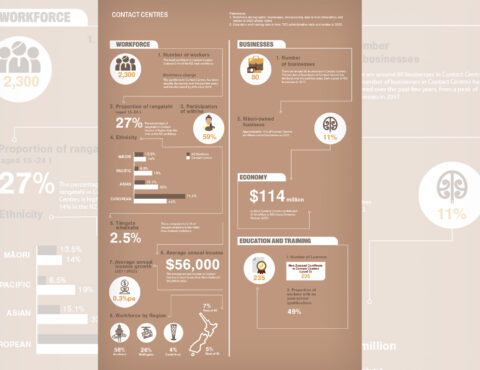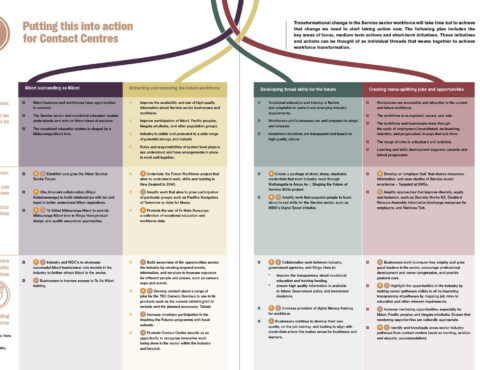Ringa Hora has worked with people from across industry to develop a shared roadmap to transform the Service sector workforce from its current state to the future that we aspire to.
The Workforce Development Plan looks across the Service sector and sets out the major factors shaping the sector and an overarching vision for the future.
Against that context, this Action Plan focuses on the characteristics and dynamics of the Contact Centre industry and its workforce. It describes what the future could look like for this workforce, the current challenges faced by the industry, and sets out the actions we can take to tackle this wero | challenge.
Ringa Hora’s Service Sector Workforce Development Plan is based on four aho | strands. Each of these aho will strengthen the workforce, but when woven together, as a taura whiri | rope, we can achieve real transformation of the workforce:
For Contact Centres this means ensuring that their work is valued and visible to all. It also means a future in which the industry is resilient and adaptable to technological advances. By providing staff with the skills and experience they need to adapt and develop in a broad sense, including in digital literacy, the industry can attract and retain more staff including good leaders who understand the industry.
We know that for Contact Centre services to flourish, the industry has to reflect the communities it serves. Contact Centre services represent one of the highest proportions of both Māori and Pacific people within the Service sector. Embracing and supporting this diverse workforce makes businesses more attractive to potential kaimahi and customers from across the motu and offshore.

The Contact Centre industry consists of a range of businesses including recruitment, call centres, office and other administrative services such as ticketing and promotions, labour supply services, and gardening.
The industry contributes $114 million to the nation’s economy and provides immense value to society as an essential service.
There has been a steady increase in demand for Contact Centre services in particular over the last few years. The upward trajectory was further accelerated by the COVID-19 pandemic and the recent weather events as an increasing proportion of New Zealand businesses have been introducing online distribution channels for their products and services. This in turn results in the need for more customer service support. In addition, demand from online shopping is expected to continue growing, providing the industry with an opportunity to expand.

To help us get to the future state, we need to understand and tackle the challenges that the Contact Centre industry faces, while also seizing the opportunities that already exist or are on the horizon. We’ve heard that the factors which have a significant impact on the Contact Centre industry, including its approach to workforce development include low public perceptions of the industry, high turnover, and a need for skills and experience to address increasing complexity of the work. The industry also needs leaders who can lead across the changes caused by digital disruption and increasing complexity of demands.
Raising the profile of the industry for the future workforce
It is vital that the future workforce has better visibility about the industry and what it offers.
Generally, people are not aware of what it entails, what it involves, salary opportunities and the career progression. Good news stories from people on the job may be a way to promote the industry, although these need to be sourced and shared well to be effective. Very few (less than 3%) of new workers to contact centres in particular join from secondary school. The sector could work better with careers advisors and managers and possibly provide opportunities for work experience to attract young school leavers into the sector.
Building a depth of experience
Contact Centre services have a very high turnover rate and large parts of the workforce do not have depth of experience. In 2021, less than a third of the workforce had more than two years of experience in the industry. Steps could be taken to improve re-balance efforts from attraction to retention, which will in turn improve the depth of workforce experience, and ultimately improve the quality of service for New Zealand.
Developing skills and experience to deal with the complexity of work
The industry is increasingly demanding staff who excel in customer service, problem-solving and can rapidly adopt technology while being able to work beyond the standard 9–5 settings. Automation has helped to reduce the more basic interactions; however, it also means that the nature of issues needing to be resolved by contact centre operators have become more complex, customer expectations have increased, and the level of skill required has risen considerably. The increased expectations and high intensity work mean that the sector has difficulties attracting, upskilling, and retaining kaimahi.
Supporting pathways to leadership
The industry needs clear pathways that enable progression, and succession planning which is tailored to suit a team and organisation needs. It is important to get the right type of leaders into Contact Centre services. Leaders need to be visible and encourage professional development and career progression and provide pastoral care. Offering clearer leadership pathways and opportunities for development provides an avenue for employees within their current job to see and stay for future leadership opportunities. A good leader also needs to assist staff on the ground during difficult times.
The Contact Centre services core workforce employs around 2,300 people. The sector has many opportunities for workers entering the workforce or changing careers to gain experience in customer service, problem-solving and rapidly adopt technology.
The industry absorbs large numbers of workers without pre-requisite tertiary qualifications. This makes it all the more important to upskill and train the existing kaimahi for them to have the skills they need and to encourage them to stay within the sector.
Prior to the pandemic, there was a growing number of migrant workers in the Contact Centre workforce. These trends of an increasing migrant workforce highlight the need for the industry to embrace its cultural and linguistic diversity.
The industry has a high proportion of Māori and Pacific peoples in the workforce. Embracing and celebrating diversity makes businesses more attractive to potential kaimahi and customers, as well as creating economic and social benefits for employers, the workforce, and the wider community.
Using workforce participation data as a starting point shows that there are some strengths in the industry, but also work to be done to realise the aspirations and potential of Māori, Pacific peoples, and tāngata whaikaha | disabled people:
![]()
There is a high proportion of Māori in the Contact Centre workforce. This is likely because many Māori can see themselves reflected in the industry. There are clear pathways for many Māori into specific industries and into management and leadership roles. Many industries use contact centres as a training ground pathway into other roles, such as finance and banks. In addition, there are a number of Māori-owned businesses in the industry (11%) which often focus on supporting Māori in the industry.
![]()
Contact Centres have a high proportion of Pacific peoples, compared to both the Service sector more broadly and the New Zealand workforce. The sector provides clear pathways to leadership and managerial roles which provides opportunities for Pacific peoples in terms of career progression and skill development. The sector is well aligned with Pacific values, particularly its focus on reciprocity and assisting others, and working collaboratively as a team. Having a high proportion of Pacific peoples enables Contact Centres to better understand and respond to the needs of their increasingly diverse customers.
![]()
Tāngata whaikaha includes physical, mental, intellectual, or sensory impairments which can impact a person’s life to varying degrees and in different ways. We acknowledge that data on tāngata whaikaha is limited and it is important that we create more growth opportunities within the sector for our tāngata whaikaha workforce.

Explore the Contact Centre industry workforce demographic, business, and economy statistics, and education and training data.

Transformational change in the Service sector workforce will take time but to achieve that change we need to start taking action now. The Contact Centre action plan includes the key areas of focus, medium-term actions and short-term initiatives. These initiatives and actions can be thought of as individual threads that weave together to achieve workforce transformation.